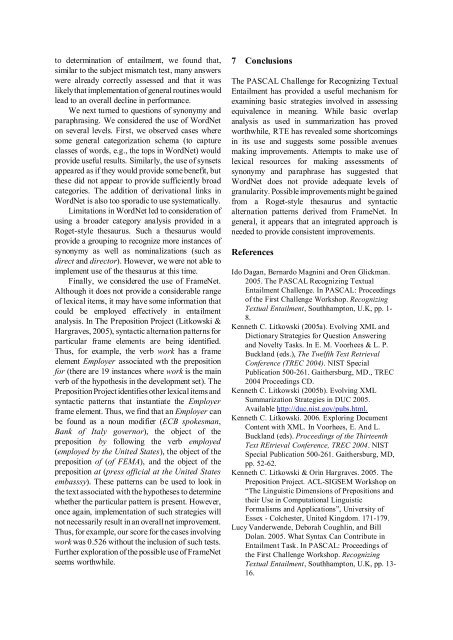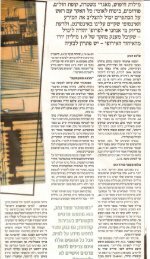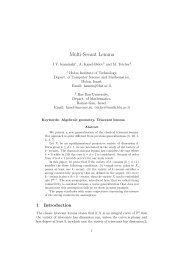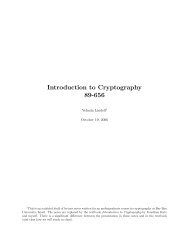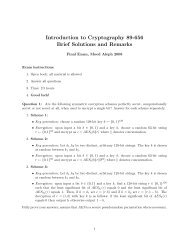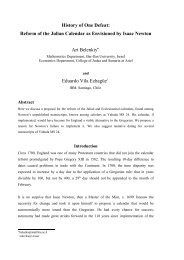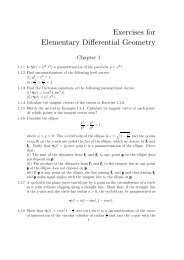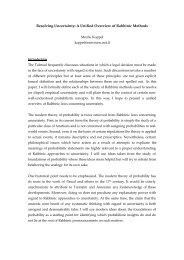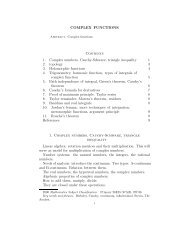Componential Analysis for Recognizing Textual Entailment
Componential Analysis for Recognizing Textual Entailment
Componential Analysis for Recognizing Textual Entailment
You also want an ePaper? Increase the reach of your titles
YUMPU automatically turns print PDFs into web optimized ePapers that Google loves.
to determination of entailment, we found that,similar to the subject mismatch test, many answerswere already correctly assessed and that it waslikely that implementation of general routines wouldlead to an overall decline in per<strong>for</strong>mance.We next turned to questions of synonymy andparaphrasing. We considered the use of WordNeton several levels. First, we observed cases wheresome general categorization schema (to captureclasses of words, e.g., the tops in WordNet) wouldprovide useful results. Similarly, the use of synsetsappeared as if they would provide some benefit, butthese did not appear to provide sufficiently broadcategories. The addition of derivational links inWordNet is also too sporadic to use systematically.Limitations in WordNet led to consideration ofusing a broader category analysis provided in aRoget-style thesaurus. Such a thesaurus wouldprovide a grouping to recognize more instances ofsynonymy as well as nominalizations (such asdirect and director). However, we were not able toimplement use of the thesaurus at this time.Finally, we considered the use of FrameNet.Although it does not provide a considerable rangeof lexical items, it may have some in<strong>for</strong>mation thatcould be employed effectively in entailmentanalysis. In The Preposition Project (Litkowski &Hargraves, 2005), syntactic alternation patterns <strong>for</strong>particular frame elements are being identified.Thus, <strong>for</strong> example, the verb work has a frameelement Employer associated wth the preposition<strong>for</strong> (there are 19 instances where work is the mainverb of the hypothesis in the development set). ThePreposition Project identifies other lexical items andsyntactic patterns that instantiate the Employerframe element. Thus, we find that an Employer canbe found as a noun modifier (ECB spokesman,Bank of Italy governor), the object of thepreposition by following the verb employed(employed by the United States), the object of thepreposition of (of FEMA), and the object of thepreposition at (press official at the United Statesembasssy). These patterns can be used to look inthe text associated with the hypotheses to determinewhether the particular pattern is present. However,once again, implementation of such strategies willnot necessarily result in an overall net improvement.Thus, <strong>for</strong> example, our score <strong>for</strong> the cases involvingwork was 0.526 without the inclusion of such tests.Further exploration of the possible use of FrameNetseems worthwhile.7 ConclusionsThe PASCAL Challenge <strong>for</strong> <strong>Recognizing</strong> <strong>Textual</strong><strong>Entailment</strong> has provided a useful mechanism <strong>for</strong>examining basic strategies involved in assessingequivalence in meaning. While basic overlapanalysis as used in summarization has provedworthwhile, RTE has revealed some shortcomingsin its use and suggests some possible avenuesmaking improvements. Attempts to make use oflexical resources <strong>for</strong> making assessments ofsynonymy and paraphrase has suggested thatWordNet does not provide adequate levels ofgranularity. Possible improvements might be gainedfrom a Roget-style thesaurus and syntacticalternation patterns derived from FrameNet. Ingeneral, it appears that an integrated approach isneeded to provide consistent improvements.ReferencesIdo Dagan, Bernardo Magnini and Oren Glickman.2005. The PASCAL <strong>Recognizing</strong> <strong>Textual</strong><strong>Entailment</strong> Challenge. In PASCAL: Proceedingsof the First Challenge Workshop. <strong>Recognizing</strong><strong>Textual</strong> <strong>Entailment</strong>, Southhampton, U.K, pp. 1-8.Kenneth C. Litkowski (2005a). Evolving XML andDictionary Strategies <strong>for</strong> Question Answeringand Novelty Tasks. In E. M. Voorhees & L. P.Buckland (eds.), The Twelfth Text RetrievalConference (TREC 2004). NIST SpecialPublication 500-261. Gaithersburg, MD., TREC2004 Proceedings CD.Kenneth C. Litkowski (2005b). Evolving XMLSummarization Strategies in DUC 2005.Available http://duc.nist.gov/pubs.html.Kenneth C. Litkowski. 2006. Exploring DocumentContent with XML. In Voorhees, E. And L.Buckland (eds). Proceedings of the ThirteenthText REtrieval Conference, TREC 2004. NISTSpecial Publication 500-261. Gaithersburg, MD,pp. 52-62.Kenneth C. Litkowski & Orin Hargraves. 2005. ThePreposition Project. ACL-SIGSEM Workshop on“The Linguistic Dimensions of Prepositions andtheir Use in Computational LinguisticFormalisms and Applications”, University ofEssex - Colchester, United Kingdom. 171-179.Lucy Vanderwende, Deborah Coughlin, and BillDolan. 2005. What Syntax Can Contribute in<strong>Entailment</strong> Task. In PASCAL: Proceedings ofthe First Challenge Workshop. <strong>Recognizing</strong><strong>Textual</strong> <strong>Entailment</strong>, Southhampton, U.K, pp. 13-16.


